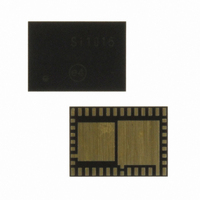SI1005-C-GM Silicon Laboratories Inc, SI1005-C-GM Datasheet - Page 247

SI1005-C-GM
Manufacturer Part Number
SI1005-C-GM
Description
IC TXRX MCU + EZRADIOPRO
Manufacturer
Silicon Laboratories Inc
Specifications of SI1005-C-GM
Package / Case
42-QFN
Frequency
240MHz ~ 960MHz
Data Rate - Maximum
256kbps
Modulation Or Protocol
FSK, GFSK, OOK
Applications
General Purpose
Power - Output
13dBm
Sensitivity
-121dBm
Voltage - Supply
0.9 V ~ 1.8 V
Current - Receiving
18.5mA
Current - Transmitting
30mA
Data Interface
PCB, Surface Mount
Memory Size
32kB Flash, 4kB RAM
Antenna Connector
PCB, Surface Mount
Number Of Receivers
1
Number Of Transmitters
1
Wireless Frequency
240 MHz to 960 MHz
Interface Type
UART, SMBus, SPI, PCA
Output Power
13 dBm
Operating Supply Voltage
0.9 V to 3.6 V
Maximum Operating Temperature
+ 85 C
Mounting Style
SMD/SMT
Maximum Supply Current
4.1 mA
Minimum Operating Temperature
- 40 C
Modulation
FSK, GFSK, OOK
Protocol Supported
C2, SMBus
Core
8051
Program Memory Type
Flash
Program Memory Size
32 KB
Data Ram Size
4352 B
Supply Current (max)
4.1 mA
Lead Free Status / RoHS Status
Lead free / RoHS Compliant
Operating Temperature
-
Lead Free Status / Rohs Status
Lead free / RoHS Compliant
Other names
336-1875-5
Available stocks
Company
Part Number
Manufacturer
Quantity
Price
Company:
Part Number:
SI1005-C-GM
Manufacturer:
Silicon Labs
Quantity:
135
- Current page: 247 of 376
- Download datasheet (3Mb)
The chip will automatically shift the frequency of the Synthesizer down by 937.5 kHz (30 MHz ÷ 32) to
achieve the correct Intermediate Frequency (IF) when RX mode is entered. Low-side injection is used in
the RX Mixing architecture; therefore, no frequency reprogramming is required when using the same TX
frequency and switching between RX/TX modes.
23.3.3. Easy Frequency Programming for FHSS
While Registers 73h–77h may be used to program the carrier frequency of the transceiver, it is often easier
to think in terms of “channels” or “channel numbers” rather than an absolute frequency value in Hz. Also,
there may be some timing-critical applications (such as for Frequency Hopping Systems) in which it is
desirable to change frequency by programming a single register. Once the channel step size is set, the fre-
quency may be changed by a single register corresponding to the channel number. A nominal frequency is
first set using Registers 73h–77h, as described above. Registers 79h and 7Ah are then used to set a chan-
nel step size and channel number, relative to the nominal setting. The Frequency Hopping Step Size
(fhs[7:0]) is set in increments of 10 kHz with a maximum channel step size of 2.56 MHz. The Frequency
Hopping Channel Select Register then selects channels based on multiples of the step size.
For example: if the nominal frequency is set to 900 MHz using Registers 73h–77h and the channel step
size is set to 1 MHz using "Register 7Ah. Frequency Hopping Step Size". For example, if the "Register
79h. Frequency Hopping Channel Select" is set to 5d, the resulting carrier frequency would be 905 MHz.
Once the nominal frequency and channel step size are programmed in the registers, it is only necessary to
program the fhch[7:0] register in order to change the frequency.
10
12
13
14
15
16
17
18
19
20
21
22
23
11
9
Table 23.3. Frequency Band Selection (Continued)
F
carrier
Fnom
33
34
35
36
37
38
39
40
41
42
43
44
45
46
47
fhs
[
: 7
Rev. 1.0
330–339.9 MHz
340–349.9 MHz
350–359.9 MHz
360–369.9 MHz
370–379.9 MHz
380–389.9 MHz
390–399.9 MHz
400–409.9 MHz
410–419.9 MHz
420–429.9 MHz
430–439.9 MHz
440–449.9 MHz
450–459.9 MHz
460–469.9 MHz
470–479.9 MHz
] 0
(
fhch
[
: 7
] 0
10
660–679.9 MHz
680–699.9 MHz
700–719.9 MHz
720–739.9 MHz
740–759.9 MHz
760–779.9 MHz
780–799.9 MHz
800–819.9 MHz
820–839.9 MHz
840–859.9 MHz
860–879.9 MHz
880–899.9 MHz
900–919.9 MHz
920–939.9 MHz
940–960 MHz
kHz
Si1000/1/2/3/4/5
)
247
Related parts for SI1005-C-GM
Image
Part Number
Description
Manufacturer
Datasheet
Request
R
Part Number:
Description:
SMD/C°/SINGLE-ENDED OUTPUT SILICON OSCILLATOR
Manufacturer:
Silicon Laboratories Inc
Part Number:
Description:
Manufacturer:
Silicon Laboratories Inc
Datasheet:
Part Number:
Description:
N/A N/A/SI4010 AES KEYFOB DEMO WITH LCD RX
Manufacturer:
Silicon Laboratories Inc
Datasheet:
Part Number:
Description:
N/A N/A/SI4010 SIMPLIFIED KEY FOB DEMO WITH LED RX
Manufacturer:
Silicon Laboratories Inc
Datasheet:
Part Number:
Description:
N/A/-40 TO 85 OC/EZLINK MODULE; F930/4432 HIGH BAND (REV E/B1)
Manufacturer:
Silicon Laboratories Inc
Part Number:
Description:
EZLink Module; F930/4432 Low Band (rev e/B1)
Manufacturer:
Silicon Laboratories Inc
Part Number:
Description:
I°/4460 10 DBM RADIO TEST CARD 434 MHZ
Manufacturer:
Silicon Laboratories Inc
Part Number:
Description:
I°/4461 14 DBM RADIO TEST CARD 868 MHZ
Manufacturer:
Silicon Laboratories Inc
Part Number:
Description:
I°/4463 20 DBM RFSWITCH RADIO TEST CARD 460 MHZ
Manufacturer:
Silicon Laboratories Inc
Part Number:
Description:
I°/4463 20 DBM RADIO TEST CARD 868 MHZ
Manufacturer:
Silicon Laboratories Inc
Part Number:
Description:
I°/4463 27 DBM RADIO TEST CARD 868 MHZ
Manufacturer:
Silicon Laboratories Inc
Part Number:
Description:
I°/4463 SKYWORKS 30 DBM RADIO TEST CARD 915 MHZ
Manufacturer:
Silicon Laboratories Inc
Part Number:
Description:
N/A N/A/-40 TO 85 OC/4463 RFMD 30 DBM RADIO TEST CARD 915 MHZ
Manufacturer:
Silicon Laboratories Inc
Part Number:
Description:
I°/4463 20 DBM RADIO TEST CARD 169 MHZ
Manufacturer:
Silicon Laboratories Inc











